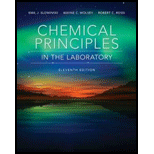
Each of the observations in the following list was made on a different solution. Given the observations, state which ion studied in this experiment is present. If the test is not definitive, indicate that with a question mark.
A. Addition of
Ion present:
B. Addition
Ion present:
C. Addition of
Ion present:
D. Addition of
Ion present:
E. Addition of
Ion present:
F. Addition of
Ion present:
(a)
Interpretation:
To identify the ion present in the solution that gives the observation: The addition of 6 M NaOH and Al to the solution produces a vapor that turns red litmus blue.
Concept Introduction :
Different ions (Cations or anions) present in the solution can be detected using different tests as these ions behave differently in terms of their chemical reactions.
Answer to Problem 1ASA
Nitrate ion (
Explanation of Solution
This test is known as Devarda’s test and is given by nitrate ions (
In this test, Devarda’s alloy (Al alloy) acts as a reducing agent and is reacted with nitrate ion in the sodium hydroxide (NaOH) solution. As a result, ammonia gas is produced that turns red litmus blue.
The reaction taking place is-
Hence, the ion present is the Nitrate ion.
(b)
Interpretation:
To identify the ion present in the solution that gives the observation: Adding 6 M HCl produces a vapor with an acrid odor.
Concept Introduction :
Different ions (Cations or anions) present in the solution can be detected using different tests as these ions behave differently in terms of their chemical reactions.
Answer to Problem 1ASA
Sulfite ion (
Explanation of Solution
Acrid odor is a strong smell that may cause a burning sensation in the throat.
This acrid odor represents the release of Sulfur dioxide (
And
Hence, the ion present is the sulfite ion.
(C)
Interpretation:
To identify the ion present in the solution that gives the observation: Adding 6 M HCl produces an effervescence.
Concept Introduction :
Different ions (Cations or anions) present in the solution can be detected using different tests as these ions behave differently in terms of their chemical reactions.
Answer to Problem 1ASA
Carbonate ion (
Explanation of Solution
Effervescence formation means carbon dioxide gas is released during this test and carbonate ions release
Hence, the ion present is the Carbonate ion.
(D)
Interpretation:
To identify the ion present in the solution that gives the observation: Adding 6 M
Concept Introduction :
Different ions (Cations or anions) present in the solution can be detected using different tests as these ions behave differently in terms of their chemical reactions.
Answer to Problem 1ASA
Halide ions (
Explanation of Solution
This test is a Silver nitrate test and is given by halide ions (
In this test, Silver ions react with halide ions to form the precipitate of silver halides. Nitric acid is added to remove interfering ions.
Hence, the ion present is either chloride ions or bromide ions, or iodide ions.
(E)
Interpretation:
To identify the ion present in the solution that gives the observation: Adding of 6 M
Concept Introduction :
Different ions (Cations or anions) present in the solution can be detected using different tests as these ions behave differently in terms of their chemical reactions.
Answer to Problem 1ASA
Sulfate (
Explanation of Solution
Sulfate (
Hence, the ion present is a sulfate ion.
(F)
Interpretation:
To identify the ion present in the solution that gives the observation: Adding of 6 M
Concept Introduction :
Different ions (Cations or anions) present in the solution can be detected using different tests as these ions behave differently in terms of their chemical reactions.
Answer to Problem 1ASA
Phosphate (
Explanation of Solution
Phosphate (
Hence, the ion present is the phosphate ion.
Want to see more full solutions like this?
Chapter 35 Solutions
Chemical Principles in the Laboratory
- Nonearrow_forward3. A molecular form of "dicarbon", C2, can be generated in gas phase. Its bond dissociation energy has been determined at 599 kJ/mol. Use molecular orbital theory to explain why energy of dissociation for C₂+ is 513 kJ/mol, and that for C2² is 818 kJ/mol. (10 points)arrow_forward9.73 g of lead(IV) chloride contains enough Cl- ions to make ____ g of magnesium chloride.arrow_forward
- 6. a) C2's. Phosphorus pentafluoride PF5 belongs to D3h symmetry group. Draw the structure of the molecule, identify principal axis of rotation and perpendicular (4 points) b) assume that the principal axis of rotation is aligned with z axis, assign symmetry labels (such as a1, b2, etc.) to the following atomic orbitals of the P atom. (character table for this group is included in the Supplemental material). 3s 3pz (6 points) 3dz²arrow_forward2. Construct Lewis-dot structures, and draw VESPR models for the ions listed below. a) SiF5 (4 points) b) IOF4 (4 points)arrow_forward5. Complex anion [AuCl2]¯ belongs to Doh symmetry point group. What is the shape of this ion? (4 points)arrow_forward
- 4. Assign the following molecules to proper point groups: Pyridine N 1,3,5-triazine N Narrow_forward7. a) Under normal conditions (room temperature & atmospheric pressure) potassium assumes bcc lattice. Atomic radius for 12-coordinate K atom is listed as 235 pm. What is the radius of potassium atom under normal conditions? (3 points) b) Titanium metal crystallyzes in hcp lattice. Under proper conditions nitrogen can be absorbed into the lattice of titanium resulting in an alloy of stoichiometry TiNo.2. Is this compound likely to be a substitutional or an interstitial alloy? (Radius of Ti (12-coordinate) is 147 pm; radius of N atom is 75 pm. (3 points)arrow_forwardcan someone answer the questions and draw out the complete mechanismarrow_forward
- Chemistry: Matter and ChangeChemistryISBN:9780078746376Author:Dinah Zike, Laurel Dingrando, Nicholas Hainen, Cheryl WistromPublisher:Glencoe/McGraw-Hill School Pub Co
 Chemistry by OpenStax (2015-05-04)ChemistryISBN:9781938168390Author:Klaus Theopold, Richard H Langley, Paul Flowers, William R. Robinson, Mark BlaserPublisher:OpenStax
Chemistry by OpenStax (2015-05-04)ChemistryISBN:9781938168390Author:Klaus Theopold, Richard H Langley, Paul Flowers, William R. Robinson, Mark BlaserPublisher:OpenStax

